M. Isidora Forrest's Blog, page 16
January 15, 2023
Isis the Alchemist
 Miriam, the Hebrew prophetess; from the Dormition Church in Jerusalem; photo by Deror Avi
Miriam, the Hebrew prophetess; from the Dormition Church in Jerusalem; photo by Deror AviLike Her fellow Magician Deity, Hermes Trismegistos (aka Thoth), Our Lady Isis is associated with early alchemy. In an alchemical text with the lengthy title The True Book of Sophe the Egyptian and of the God of the Hebrews, Lord of the Powers, Sabaoth, we learn of a particular alchemical method called the Tincture of Isis. Why are Isis and Her tincture mentioned in a book “of the God of the Hebrews”?
Perhaps it has to do with another famous alchemical text in which Isis plays the leading role and which seems to have a particularly Old Testament ring to it. The text is called Isis the Prophetess to Her Son Horos. We have only two fragmentary versions of the text. One comes from the 11th-century-CE Codex Marcianus, which was a collection of ancient texts and bits of texts. See if this story doesn’t sound a bit familiar…
The story of Isis the Prophetess
Horus sets out to battle Typhon and Isis goes to the city of Hormanouthi “where the Sacred Art of Egypt is practiced in secret.” Hormanouthi is an uncertain place. Some have taken it as a mistake for Hormachythi, that is “the place of Horus”—Hor in Egyptian—at Edfu. Edfu did have what Egyptologists have called a laboratory and it is one of the places from which we have the recipe for the famous kyphi incense. Others want to identify it with Hermopolis, Thoth’s city.
Whatever the case, Isis stays there a while, but as She is leaving, an angel catches sight of Her and wants to have sex with Her.
“Not until you tell me of the preparation of gold and silver,” says Isis.
Highly disappointed, the angel says He can’t reveal that information as it is such a Great Mystery, but that a higher angel, Amnael, would come the next day and be able to answer the question.
Next day, Amnael comes. He showed Isis a “certain sign” He had on His head as well as a vase “not coated with pitch” and filled with transparent water that He held in His hands, but He wouldn’t give Her the secret.
 “…the man who sows wheat also harvests wheat…”
“…the man who sows wheat also harvests wheat…”Apparently, Amnael, “first prophet and angel among them,” is also taken with lust for the Goddess and the two go back and forth on that topic for a couple of days until Amnael can’t stand it anymore and agrees to reveal the alchemical secrets to Isis. First He has Her swear a mighty oath by “fire and water, light and darkness, by fire, water, air, and earth,” and by a variety of Greek and Egyptian Deities. She so swears and promises that She would not reveal the secrets to anyone but Horus.
And here is the great secret. Ready?
So go then, my child, to a certain laborer named Achaab, and ask him what he has sown and what he has harvested, and you will learn from him that the man who sows wheat also harvests wheat, and the man who sows barley also harvests barley. For a nature rejoices another nature, and a nature conquers another nature.
Isis the Prophetess to Her Son Horos
So now you know the Mystery. (Not too exciting on the face of it, is it?) What we don’t know from the fragments left to us is whether Isis ever actually had to give it up for this information or whether She just wore the angel down with Her consistent refusals and constant questions. Perhaps after all that revelation of mysteries, the angel was no longer in the mood.
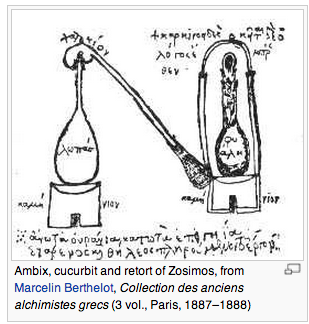
You might have recognized in this tale echoes of the old “randy angels” story of Enoch. The sons of heaven desired the daughters of men. After they mated with them, the angels taught the women all the crafts, which was forbidden—though very useful—knowledge. It’s another Eve story. Sigh. Woman does what she has to in order to get the information everybody needs—knowledge of good and evil; knowledge of crafts—but then she gets reviled for it.
Happily, we don’t see that happen in the Isis the Prophetess story. Apparently, Isis passes this vital alchemical secret down to Horus, and to Her other alchemical sons and daughters (yes, women were alchemists, too). This story should also remind us of the story of Isis & Re in which Isis uses a trick to gain vital knowledge from the Sun God—the knowledge of His powerful, magical name—and which She again passes to Her child.
Umm, the Tincture of Isis?
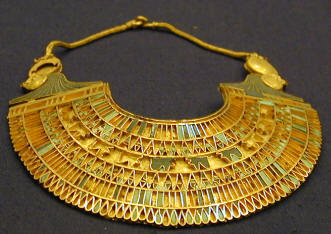 Made with “the tincture of Isis”?
Made with “the tincture of Isis”?So the story gives us the connection between Isis and Hebrew tradition, but what is the Tincture of Isis? The great Mystery revealed by the angel means something like “you reap what you sow” or “you’ve got to spend money to make money.” It refers to the method of alloying a small amount of gold with another metal to make a greater amount of gold. We still do this. 24-karat gold is 99.9% gold. But 14-karat gold is only slightly over half gold. 14 karat and even 10 karat are common for jewelry. The Tincture of Isis was this secret….that you can alloy gold with other metals and still produce perfectly serviceable gold.
A famous Egyptian alchemist of the 3rd century CE, Zosimos, wrote that in Egypt, the methods of working metal and alchemy were a carefully guarded royal and priestly secret and that it was illegal to publish anything on the subject. This could mean that there truly was an ancient and secret Egyptian tradition of the transmutation of metals. Zosimos also tells us that Isis’ temple at Memphis had alchemical inscriptions. He writes, “At the eastern entry of Isis’ temple, you’ll see characters dealing with the white substance [silver]; at the western entry, you’ll find the yellow mineral [gold] near the orifice of the Three Springs.”

Isis’ connection with alchemy only grew with time. As we follow Her into the world of Renaissance and post-Renaissance Europe, Isis, the Lady of Many Names, appears to us under a variety of guises appropriate for a Goddess of Alchemy. She is the Virgin of the World Who bears the alchemical Child of the Sun and the Moon. She is understood as Luna, the Moon and the Ruler of its Powers. She is Nature, or Physis Whose ways the alchemists strive to emulate. She is the alchemical Queen and Bride Who weds the Solar King. She is the Anima Mundi, the Soul of the World, the spirit of life itself. She is Sophia, the Lady of Wisdom both Divine and Natural. And She is the Lady Venus, the Veiled Goddess of the Rosicrucians, Who is revealed only to true initiates.
For alchemists, the myth of Isis and Osiris was a myth of the alchemical process. The theme of dismemberment and reassembly was a mythic statement of the alchemical motto: solve et coagula— dissolve and re-join; while the birth of the Divine Child from parents identified with the Moon and Sun, as Isis and Osiris had long been, could not have been more alchemical.
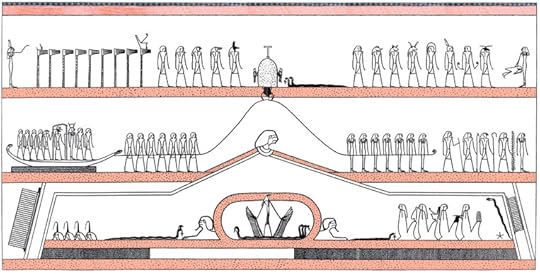 The 5th Hour of the Night is filled with alchemical flames of fire from the mouth of Isis
The 5th Hour of the Night is filled with alchemical flames of fire from the mouth of Isis
January 8, 2023
Isis, the Powerful Goddess of the Eye
 A solar Eye Goddess Isis
A solar Eye Goddess IsisIf you’ve been following along with this blog, you’ll have already seen a number of posts about Isis as one of the protective and fierce Eye Goddesses.
Most recently, we’ve seen how She is likely to be among the wandering and returning Goddesses, in the mold of Sakhmet and Tefnut, Who all have a form as a fiery Divine Eye. (You can read about that here, here, and here.)

One of the words scholars often use to describe these Eye Goddesses is “apotropaic.” It is a useful word, of Greek origin, that means “averting” or “turning away.” These Eye Goddesses are so powerful because They can turn away or avert evil.
With Their fiery nature, They are often said to be the Daughters of the Sun God. They protect Their father and destroy His enemies for Him.
In fact, without Them, He is severely weakened, which is why it is important that, when They wander, They must always be persuaded return home…with much rejoicing among the people upon Their return.
There are more interesting things we can learn about these Goddesses of the Eye. So today, let’s take a little deeper dive into the powers of the Egyptian Goddesses of the Eye including, of course, Our Lady Isis and the Beautiful Sister, Nephthys.
Like the other Eye Goddesses, Isis is a Daughter of the Sun God Re. She is said to “emerge” from Re or “come forth” from His body. At Philae, inscriptions say that She “appears” as the Eye of Re. She is even called Re’et, the Female Re, and “the Re’et of Re’ets,” thus She is the quintessential Re Goddess.
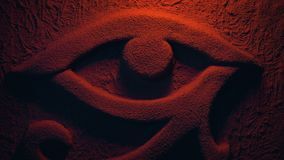
The Divine Eye Goddesses have several common forms: feline and serpentine. While They are usually lionesses, sometimes They take the form of cats (like Bastet). Very often, They are uraeus serpents. The uraeus is the cobra often seen coiled on the headdresses of Deities or royals. The weapon these Divine Serpents wield is fire, breathed forth from Their mouths. It destroys. It purifies. Together, Isis and Nepththys are the Two Uraei, the Two Fiery Cobras, the Two Eyes of God. An inscription at Philae calls Isis “Neseret-serpent on the head of Horus-Re, Eye of Re, the Unique Goddess, Uraeus” and “Eye of Re Who has No Equal in Heaven and on Earth.” Nephthys is “Brilliant on the Forehead of Re” and the one “Whose Flame is Painful.”
 Solar Eye Goddess as uraeus, spitting fire
Solar Eye Goddess as uraeus, spitting fireIn ancient Egyptian lore, the Eye Goddesses are usually associated with the solar eye, the eye of Re, the Sun God. In this form, Isis is “the right eye of He Who shines like gold” and She is the solar disk, the Aten Itself. But if there is a solar eye, there is also a lunar eye. Most often, this is the Udjat Eye, the famous Eye of Horus. Udjat means complete or whole, referring to the full moon. Because of its perpetual healing as it becomes full, the Eye of Horus is associated with protection and healing of all kinds; it also became the ideal offering and could represent all other offerings. (As with so many Things Egyptian, these definitions and categorizations are flexible. Re’s eyes could be the sun and the moon. Horus is also a solar God and so could have a solar eye as well. At Denderah, Isis as Re’et is “in the dual course of the sun and the moon,” and thus encompasses both solar and lunar eyes.)
Egyptian texts sometimes give particular attention to a specific part of the Divine Eye: the pupil or the pupil-and-iris. Interestingly, the pupil is associated—not with fire or light as is the Eye as a whole—but with moisture. One hymn to the Solar God notes that His eyes are the sun and moon, but His pupil-and-iris is the dew. The fiery Tefnut, grandmother of Isis and one of our Eye Goddesses, is also associated with moisture. Isis Herself is specifically connected with dew. One of the magical papyri (PGM XII, 234-5) has Isis say of Herself, “I am Isis called dew.” A hymn to Isis in one of the Oxyrhynchus papyri (Oxyrhynchus Papyrus XI.1380) makes Her bringer of “all rain, every spring, all dew, and snow.” At Her Philae temple, She is “the rain cloud that makes green the field when She descends.”
 Sopdet, the Godddess of Sirius by Ricardo Dieguez.
Sopdet, the Godddess of Sirius by Ricardo Dieguez.In the paper about our apotropaic Eye Goddesses that I’m reading, Egyptologist John Coleman Darnell suggests that the returning solar Eye Goddess, in this case Isis, is moisture-laden and thus brings back the desirable Inundation to Egypt when She returns from Her wandering.
That said, it is not as the Fiery One that our Eye Goddesses return. When They return, They have been “pacified” and “cooled” by the waters. They return in Their joyful rather than rage-full state.
 Sirius rising before the sun
Sirius rising before the sunAs you already know, Isis is strongly connected with the Inundation as Isis-Sothis, the bringer of the flood. When the Star of Isis, Sirius, rose just before the sun, the ancient Egyptians knew that the life-giving waters were on their way. The Divine Eye is no longer red and raging. Instead, Her return is calm, reflected in the cool blue light of Her star.
But I won’t dwell on this part of the tale now. Isis’ connection to the Inundation is so well established and familiar to most of you. For now, I’d like to return to the pupil of the Divine Eye. Why? Because I think it may connect with a later piece of Isis lore found in the Hermetica. Bear with me here and let’s see where this goes.
There are a number of ancient Egyptian amulets in the shape of the Divine Eye that include an image of a Goddess in the area where the Eye’s pupil would be. Artistically, this makes sense; if you’re going to add a figure, that would be the place to add it. It also reaffirmes that the Goddess is in the Eye and is the Eye. What’s more, She is particularly associated with the pupil of the Eye—the part that actually receives light and enables us to see.
The Egyptians had an interesting idiom for the pupil of the eye (any eye; your eye, my eye). They called it “the girl (hunet or hunut) in the eye,” sometimes specifically the “girl in the Eye of Horus.” Did it come about because of the association of the Divine Eyes of Re or Horus with the Eye Goddesses? Maybe. Certainly all of the Goddesses are youthful and so may be described as a hunet, a maiden or young woman.
 The photographer reflected in the subject’s pupil
The photographer reflected in the subject’s pupilThe funny thing is that the ancient Egyptians weren’t the only ones with that expression. And they still aren’t. According to ethnologists who’ve studied such expressions, about one-third of the languages in the world have a term for the pupil of the eye that refers to a small human or human-like being. For example, Spanish speakers call the pupil the nina del ojo, the “girl of the eye,” which ultimately derives from Latin, which had the expression: pupilla, the “little girl” of the eye. Hebrew has “the little man in the eye” as well as the “daughter of the eye.”
They think it might come from the fact that, when we look into the black pupil of the eye, it acts as a mirror in which we can see a tiny reflection of ourselves, hence the idea of little person in the eye. But why is it so often a girl? I don’t know, and the researchers didn’t either. (The second most common idiom for the pupil, by the way, is something like “the seed of the eye,” which reminds us of the pupil’s essential nature.)
But what does this have to do with Isis, you so rightly ask? As one of the Eye Goddesses, She is a fiery, protective, apotropaic Goddess. In this form, She might be portrayed on amulets as within the pupil of the Divine Eye. She is eternally young, a hunet, a maiden. And Hunet is, in fact, one of Her many epithets.

I also think there’s a possibility that Isis’ ancient identification as an Eye Goddess—the Girl in the Eye—may have led to the title of one of the Hermetica: the Kore Kosmou. While what remains to us is only a fragment, it is the oldest of the philosophical writings known as the Hermetica and ascribed to Hermes Trismegistos. The Hermetica are in the form of teaching dialogs. In the Kore Kosmou, Isis is teaching Horus about the nature of the world and the souls in it. Most Hermetic treatises date from the 1st to the 3rd centuries CE. The Kore Kosmou could go back as far as 500 BCE or sometime in the 100 years after that. And because it is so much older, scholars find more Egyptian elements in it than in some of the other, later Hermetica.
Usually, Kore Kosmou (which was written in Greek) is translated into English as the Virgin of the World/Universe. But it could also be translated as the Pupil of the Eye of the Cosmos. That’s because Greek has the girl-in-the-eye expression, too. Kore in Greek is both maiden and pupil of the eye. You can read more about the Kore Kosmou here, here, and here…and discover why scholars still aren’t absolutely clear on who/Who or what the Kore of the title refers to.
While I can’t say for certain whether this is so, it seems to me a distinct possibility; that Isis is the Kore of the Kore Kosmou because She has always been one of the “Kore” or “Hunet” Goddesses, one of the powerful Goddesses of the Divine Eye.
December 31, 2022
An Isis Rite for the New Year
 The Star of Isis is directly overhead at the New Year. “Open up your head” and let the Goddess light fill you.
The Star of Isis is directly overhead at the New Year. “Open up your head” and let the Goddess light fill you.Every year at about this time, I like to remind myself of a little miracle that happens and which relates to Our Lady. I’m posting earlier than my usual Sunday because this little miracle happens tonight at midnight.
As many of you may know, the ancient Egyptian New Year began in summer and marked the beginning of the fertilizing Nile Inundation. When people saw Sirius, the Star of Isis-Sothis, rise in the pre-dawn sky, they knew the Inundation was coming and the New Year had begun.
Now, here in Portland, winter is most certainly part of our own inundating rainy season, but it is hardly in tune with the ancient Egyptian summer New Year. Yet for devotees of Isis, there is a New Year’s treat to be had.
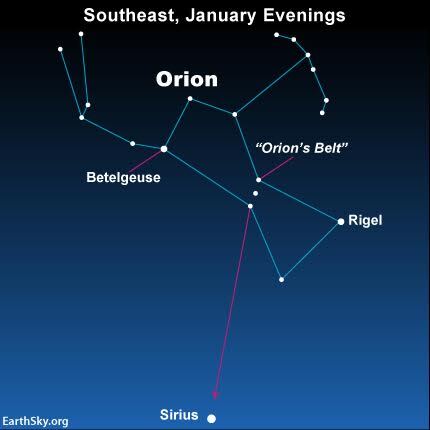 If your sky is less cloudy than mine is likely to be, here’s how to see Her
If your sky is less cloudy than mine is likely to be, here’s how to see HerYou see, for those of us in the northern hemisphere, Sirius reaches its highest point in the night sky at this time of year. The beautiful, glittering star of Isis reaches midheaven, directly above us, at midnight on New Year’s Eve, and can be seen shimmering in that position for about the first week of January. Just as the heliacal rising of Sirius heralded the ancient Egyptian New Year, so the midheaven arrival of Sirius can serve as a marker for our modern New Year’s celebration.
Isis Magic offers a New Year’s ritual in which you receive guidance for the coming year in the form of oracles from Isis and Nephthys. You can see a lovely ritual video inspired by that rite from Emily Ra here.
But in this post, I’d like to share with you a modification of the “Lotus Wand of Isis” rite, designed to help you take advantage of the presence of the Star of Isis directly overhead.

In Formula 467 of the Coffin Texts, one of the ways the deceased prepares to meet the Deities and beings of the otherworld is that they have, “come into you, having opened up my head and aroused my body…” We, too, can open up our heads and arouse our bodies for Isis so that—at this special time of year, a time of new beginnings—we may come unto Isis to receive Her magic, wisdom, power, and love, which is borne on the wings of Her starlight. At the New Year, the light of the Goddess is nothing less than a star to guide us.
In the standard Lotus Wand of Isis, we would work the energy from the top down through the energy centers in and around the central core of our bodies. In this case, opening our heads to the light of Isis is the culmination. So, we’ll work from the bottom up so that we first “arouse our bodies” and then “open up our heads” to the beautiful light of the Goddess.
The Lotus Wand of Isis for the New Year
Enter the temple, face east, and give the Sign of the Wings Of Isis. Then repeat the following statement until you are certain that it is so.
Ritualist: I am a Child of Isis. I am a Beloved of the Goddess.
Purification & Consecration
Purify and consecrate the temple using the general House of Isis method (or any method that works for you). When complete, return to the center of the temple and face east. Give the Sign of the Wings of Isis (lift up your arms as if you had wings).
Ritualist: Isis is all things and all things are Isis.

I Arouse My Body
Let your attention center in the shen (Egyptian for “circle”; an energy center in/around the body, similar to a chakra) beneath your feet. Be aware of the energy of Isis of the Earth beneath you. With a breath, draw in that energy into the shen beneath your feet
Ritualist: (Vibrating) ISIS SOTHIS. (Or, for Egyptian: ISET SOPDET).
As Her energy fills the shen, feel the Life of Isis that is the life in all things. Experience this, then with another breath, draw energy up from the shen beneath your feet to the shen between your knees.
Ritualist: (Vibrating) ISIS SOTHIS/ISET SOPDET.
As the energy flows into this shen, it, too, fills with the light of the Goddess. When you have experienced this, take another breath and draw energy from the knee shen to the shen at your genitals.
Ritualist: (Vibrating) ISIS SOTHIS/ISET SOPDET.
As the energy enters this shen, it too fills with Her strength and beauty. Let yourself feel this then, with another breath, energy is drawn from the genitals into the shen at your heart.
Ritualist: (Vibrating) ISIS SOTHIS/ISET SOPDET
As the energy flows into your heart, it fills, vibrating with life. Feel and see it shining, upheld by the energy of Isis. Experience this then, with another breath, draw energy from your heart into the shen at your throat.
Ritualist: (Vibrating) ISIS SOTHIS/ISET SOPDET.
As the energy flows into this shen, it glows with the beauty of Isis. Feel Her Words of Power in your throat, on your lips, then, with another breath, draw energy from your throat to the shen at your third eye, or forehead. Be sure to visualize this shen in the center of your brain.
Ritualist: (Vibrating) ISIS SOTHIS/ISET SOPDET.
I Open Up My Head
Let your attention be on your mind centered within your brain within your head. Release any tightness in your head, in your brain or in your mind. Feel your brain and scalp opening, relaxing. Let your mind expand.
Ritualist: O Iset Sopdet, Isis Sothis, Beautiful Herald of the New Year, I invoke You and ask You to help me be open to You. As I have aroused my body for You, help me open up my head that I may receive Your light and magic and power and wisdom and love. (Vibrating) ISIS SOTHIS/ISET SOPDET.
Let the energy of your prayer move from the third eye to the shen above your head. Open that shen as wide as you possibly can. Pull up the energy from the earth, all the way to your head and fling your head open wide to Isis, only Isis.
Filling with Her Light
Visualize the star of Isis above your head. See Her light, shining and sparkling, as you breathe and fill the shen above your head with Her beautiful light. Fill that shen until you can fill no more. When you are completely full, draw in breath and visualize starlight flowing down into your head, your third eye, your throat, and to your heart. Exhale and send the light to your genitals, knees, and the shen beneath your feet. Let the light pool beneath you. Then draw in breath and feel the light spiraling around the outside of your aura, protecting and strengthening. Let it spiral into the shen above your head. Exhale and let the light flow out to the star of Isis and into the heavens.
Repeat this circulation at least twice more.
Closing
You may sit in meditation for a time. When you are ready, move to the east and make the Sign of the Wings of Isis to close the temple.
Ritualist: Lady of the Guiding Star, Queen of the New Year, be You blessed and may Your diamond starlight always fill me. Amma, Iset.
 Yes, like this. Some the the amazing art of Andrew Gonzales. You can buy prints here. We have some of his prints as well as the oracle deck of his art.
Yes, like this. Some the the amazing art of Andrew Gonzales. You can buy prints here. We have some of his prints as well as the oracle deck of his art.
December 25, 2022
Making Offering to Isis
Many blessings of whatever winter holy days you celebrate and Merry Christmas to those who are celebrating today. On this day of gift-giving, I shall be making offering to Isis and Nephthys. It will not be as grand as the offering ritual I imagine below. But it will be what is in my heart.
Birth of Isis. Feast of ‘revealing the face’ of this Goddess with Her Ennead. Performing all the rites of the feast of robing . . . according to the ritual of the place of the First Feast. They make a great oblation of bread, beer, oxen, fowl, wine, milk, pomegranate-wine, [gazelles, oryx, ibexes], cranes, pigeons, fattened ducks, with fresh vegetables and all fruit. It is sweet to serve the Beautiful One with right offerings!
The Denderah Festival Calendar
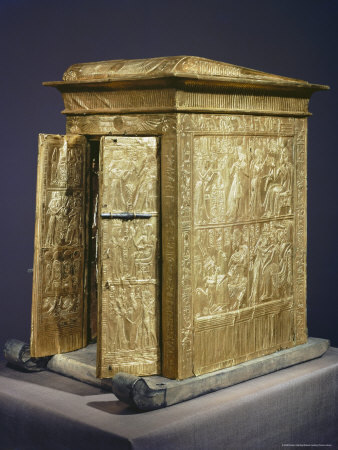 An Egyptian shrine
An Egyptian shrineEach night, while I sleep, the light is withdrawn and a darkened world returns to primordial chaos. This disorder is Isfet, the opposite of Ma’et—Rightness, Truth. Like dark water, Isfet is of infinite, even frightening, possibility. Will it seep up moist like ground water, like dreams, to nourish growth and change? Or will it burst forth, unchecked, unsettling, and destructive? Anything might happen. Anything might exist out there in night’s shadowed darkness.
The formlessness of the unillumined world is why, each morning, I welcome with full heart the awakening of the Golden One. As She scatters Her gold dust across the world—bringing light, creating form—I release my breath to Her in relieved sighs. I am Her servant. I serve the Great Goddess Isis. “Ise” is how we whisper Her holy name. I am called the First of Those Who See Her for it is my privilege and duty to open Her shrine, unveil Her face, and make offering to Her each morning. I know better than most how sweet it is to serve the Beautiful One with right offerings.
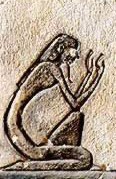 I honor Thee, Isis
I honor Thee, IsisWhile Isfet is still trembling at the edges of the world, I rise and make my purifications. My body, which will perform the ritual, is made pure with water. My mouth, which will speak the words of power, is made pure with natron. It is salty and, if I have much to purify, it sometimes makes me gag. When I am cleansed, I put on the white linen and white sandals and walk through the night-cooled corridors of the temple toward Her closed shrine.
The cooks, the bakers, the butchers have already been at work. They have prepared Her morning feast. The Pure Ones, the Wab priests and priestesses, have placed it in the Hall of Offerings and even now they chant for Her. The sistra of the priestesses rattle softly as I pass through the Hall of Offerings to finally stand before the closed doors of Her shrine.
Into the darkness before that sacred place, I speak the words that avert evil so that I may approach giving no offense and receiving no harm. I break the clay seal. I draw back the bolt, but I do not yet open the doors. For first I must offer incense to Her Eye, the fierce and fiery Serpent Goddess Who guards the Great One—and indeed Who is another of Isis’ kheperu, Her forms. When that Fierce One has taken Her pleasure and been pacified by the incense and the words of my mouth, I open the doors. Heaven and Earth open before me!
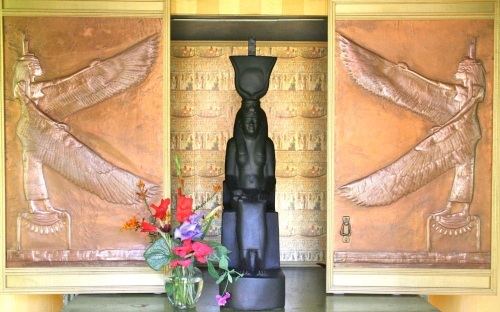 My living Isis image in Her temple shrine with flower offering
My living Isis image in Her temple shrine with flower offeringOn my knees, I enter Her shrine, offering incense. The sweet smoke rises into the still air to encircle the Iset Weret, the Great Seat or Throne of the Goddess, Her innermost holy place. My heart remembers one of the Mysteries of my temple: that Isis is She Who is Upon Her Throne, and Who is also the Throne itself, for that is the very meaning of Her name. Isis is All Things; it is a great secret that I know as I prostrate myself before the Goddess Throne. I kiss the ground. My belly touches the Earth before Her. I speak the Adoration of the Goddess with all my heart. As they do every morning that I wear the white sandals to serve my Goddess, tears blur the vision of my eyes as I lift the Goddess’ veil to look upon Her beautiful face.
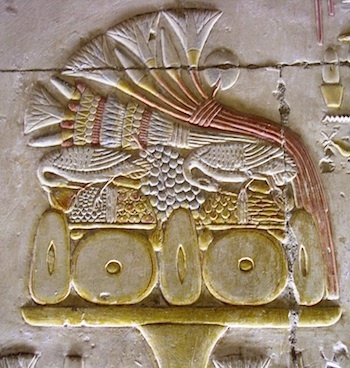 Offering table piled high
Offering table piled highIsis is alive in Her sacred image. The Goddess is at home in Her temple. I can feel Her magic vibrate within the shrine. Her ka speaks to mine. I bid Her peace in awakening. In Her presence, I purify the food offerings with water and with incense. I name what we have prepared for Her. She smiles at me with golden lips.
I am now privileged to touch Her image. I take Her sacred body from the Great Throne into the shrine chamber. I wipe away yesterday’s unguent, She having received its ka. With the little finger of my right hand, with my gentle finger, I anoint the uraeus upon Her brow anew with Eye of Horus Oil. It makes Her limbs whole. It destroys evil like the strong talons of Her falcon child.
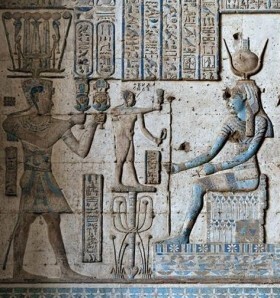 The king making offering to Isis, from Denderah
The king making offering to Isis, from DenderahI remove the linen cloths placed upon Her image the day before. They will be taken away and washed. With Her unclothed image before me, I adore Her four times. I feel tender toward the Goddess Whose body I touch. I speak only truth before Her. My adorations are never rote. I speak heart-words to my Goddess. As I re-clothe Her in fresh linens—the white, the green, and the red—I purify with natron between each dressing. I purify again with water and incense. I circle Her image four times before returning it to its seat.
Once more upon Her Great Throne, Isis receives Her ornaments and implements of power. I place them upon Her body. I offer Her precious unguents, full of power. I take up pure sand and with ancient and holy words, I pour it out before Her. It grits beneath my white sandals as I enfold Her image first in the white head cloth, then in the Great Cloth. Now She is veiled once more in the protection of the Weaving Goddesses Who spin magic into linen.
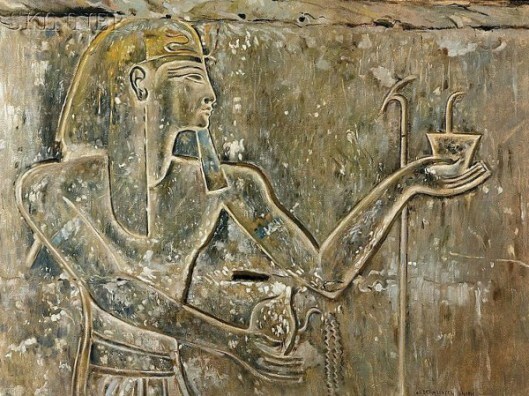 A king offering incense and pouring a libation
A king offering incense and pouring a libationAgain I offer incense and circle Her living image four times. I take up the bundle of heden plants. As I back out of the shrine, I use them to sweep the sand clean, obliterating my footprints and returning the holy place to its primordial perfection. I close the doors, bolt them. Outside, I offer incense upon the brazier and circle the room four times, speaking protections.
By the time the rite is complete, the sun is high above the horizon. Day has come. Isfet is banished. The face of Isis shines like molten gold as She smiles upon Egypt. I am content.
—from the introduction to my Offering to Isis
Making offering is one of the most ancient and eternal ways we may interact with Isis. Do you make offering? If so, what do you do?
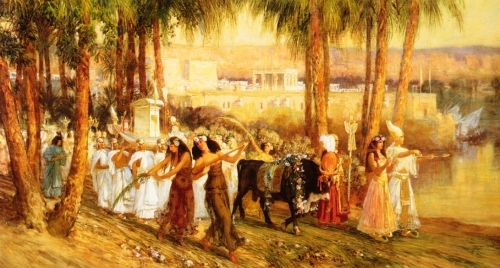 An Orientalist imagining of a procession for Isis, complete with Her shrine; art by Frederick Arthur Bridgman, mid 1800s
An Orientalist imagining of a procession for Isis, complete with Her shrine; art by Frederick Arthur Bridgman, mid 1800s
December 18, 2022
Isis & Sophia or Isis-Sophia?
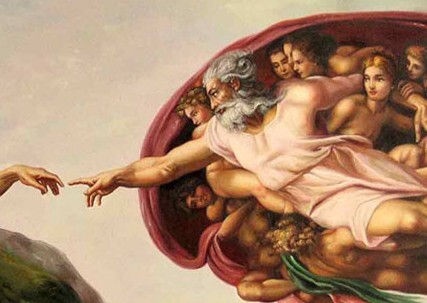 In Michelangelo’s famous Sistine Chapel painting, Wisdom (Sophia) nestles in the crook of Jehovah’s left arm during Creation
In Michelangelo’s famous Sistine Chapel painting, Wisdom (Sophia) nestles in the crook of Jehovah’s left arm during CreationThe connection between the Goddess Isis and the Goddess Wisdom (Sophia in Greek; Chokmah in Hebrew) is an interesting one. In fact, some scholars think that the figure of Sophia was patterned after Isis. And they may well be right.
So first, let’s have a look at Sophia, especially as portrayed during the Hellenistic period, the time following Alexander’s death to the rise of Rome. This is a period when the religion of Isis was strongly spreading throughout the Mediterranean world.
 Alex Grey’s powerful Sophia
Alex Grey’s powerful SophiaIt was during this time that most scholars believe the Book of Wisdom was written. The Book of Wisdom is one of the books of the Old Testament that is canonical to Roman Catholics and non-canonical to Protestants and Jews (though it may have been canonical earlier in Judaism). It is most likely that the Book of Wisdom was written in Greek, though it is stylistically patterned on Hebrew verse.
One of the interesting—and important—things that the book does is to personify Wisdom. In Hebrew, Chokmah is a feminine word and so Wisdom, when personified, is a Divine She. In Greek, the language of the Book of Wisdom, this Divine She is Sophia. Though monotheists may disagree, I feel quite comfortable referring to Sophia as a Goddess, and so I shall.
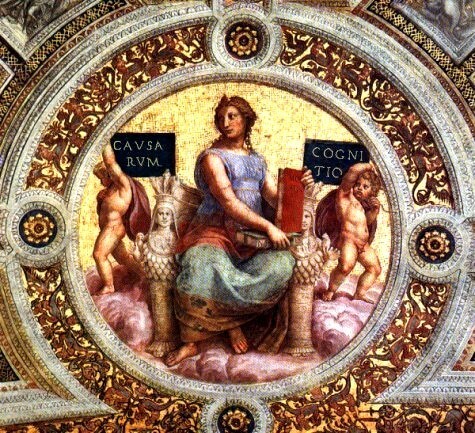 Raphael’s Sophia from the Vatican; note the two multi-breasted Goddess images on Her throne. These images of Artemis of Ephesus were identified as Isis by Raphael’s time.
Raphael’s Sophia from the Vatican; note the two multi-breasted Goddess images on Her throne. These images of Artemis of Ephesus were identified as Isis by Raphael’s time.In the Book of Wisdom, Sophia is seen to be very much like the Shekinah, the Presence of God. It is She Who “fashions all things.” She is Present from the beginning with God. If you wish to read more about Wisdom, here’s a link to the text. The best reading starts at about 6:12.
So now we’ve met Sophia. Where does She meet Isis?
For most scholars, the meeting comes in Isis’ influence on the way in which Sophia is portrayed, particularly in the Book of Wisdom. They generally agree that the writer of the Book of Wisdom shows other influences of Hellenism in the work. Given the ubiquity of Isis at the time, it would have been strange had Her portrayal not influenced the portrayal of Sophia. Many of the attributes and epithets of Sophia were also attributes of Isis. Scholar W.L. Knox went so far as to say that Sophia was the Jewish answer to the popularity of Isis:
Young Jews, seeking advancement under the Ptolemaic dynasty, might find it hard to resist the attractions of Isis. The personified Wisdom is the answer of orthodox Judaism: the source of order in creation and conduct is not Isis, but the Wisdom of God.
W. L. Knox “Divine Wisdom,” JTS 38 (1937) 230-37
Another place scholars look for the influence of Isis on Sophia is in the structure and content of the famous Isis aretalogies—the praises of the Goddess in which the Goddess speaks for Herself (I am this, I did that…). Some have made a case for the structure of the Book of Wisdom paralleling the structure of a number of the Isis aretalogies and they list parallels in the epithets of Isis and Sophia. As is natural in scholarly circles, there are criticisms of these approaches as well.
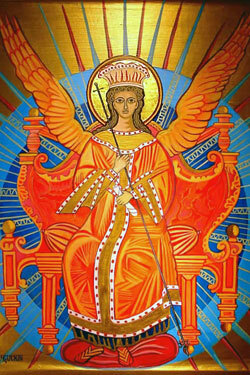 A Sophia icon
A Sophia iconIn an article in the Harvard Theological Review (“Isis & Sophia,” Vol. 75, No. 1, 1982), John Kloppenborg contends that the reason Sophia is so strongly personified in the Book of Wisdom is because of the challenge to Judaism presented by Isis. In his view, it’s not so much that the Book of Wisdom writer directly borrowed things from the myths, aretalogies, or hymns of Isis, but rather that the writer felt the need to counter the Isiac qualities so prevalent in the culture with corresponding Sophic qualities. He believes the attributes of Sophia in the Book of Wisdom were especially chosen to take on, one-to-one, the attributes for which Isis was so well known at the time.
For example, the Book of Wisdom presents itself as advice to kings; as the Goddess Throne, Isis was intimately associated with the kingship. In the Book of Wisdom, Sophia functions as a Savior, just as Isis so famously does during this time. In older Jewish tradition, while Sophia is a life-giver and a wise counselor, She is not a Savior. Now—perhaps due to the influence of the Isis religion—She is.
 Thalia Took’s lovely Sophia
Thalia Took’s lovely SophiaKloppenborg also notes the correlation of Isis’ cosmic power in the aretalogies, in Plutarch, and in Egyptian tradition with Sophia’s cosmic rule and regulation in the Book of Wisdom. Sophia’s guidance of Noah’s ark counters Isis’ role as Euploia, guide of ships and sailors. In the Book of Wisdom, Sophia is the spouse of God and of the king—just as Isis is spouse of a God and mother of the king. Sophia protects the “righteous man,” grants the ability to rule, and has “knowledge of all holy things.” Isis gives to “all who are righteous” great blessings (Hymns of Isidorus). As the Goddess Throne, She grants the right to rule, and She was always, always been the Lady of Knowledge.
Kloppenborg significantly argues that the correspondences between Isis and Sophia gave the Jews of Alexandria a way to talk with their Pagan neighbors. Outside of the Book of Wisdom, for instance, we know of Jewish philosophers who specifically compared their religion’s Mysteries with those of Orpheus and Isis.
This approach makes a great deal of good sense to me. At the time, Isis was THE Goddess for many people that it’s no wonder that She would serve as the model for the Hebrew Goddess Wisdom as well. Further, it is no wonder that Isis had and has a specific, strong, and eternal connection with the Goddess of Wisdom. Isis was always a Wisdom Goddess Herself. The Turin papyrus says of Her:
Isis was a woman wise in speech, her heart more cunning than the millions of men, her utterance was more excellent than the millions of gods, she was more perceptive than millions of glorified spirits. She was not ignorant of anything in heaven or earth. . .
Turin Papyrus
One of Isis’ Egyptian epithets is Rekhiet, the Wise Woman. She is also called Rekhit, Knowledge or Wisdom Itself. Many hundreds of years later, Plutarch continues to understand Isis as a Wisdom Goddess. He writes to his friend Klea, a priestess of Isis, that the search for Truth about the Gods shows a longing for the Divine and
…is a task well-pleasing to that goddess whom you worship, a goddess exceptionally wise and a lover of wisdom, to whom, as her name at least seems to indicate, knowledge and understanding are in the highest degree appropriate.
Plutarch, On Isis & Osiris, paragraph 2
Many of the names of Isis from the later Invocation of Isis in the show Her clear identity as a Goddess of Wisdom as well. So, anyone writing about a Wisdom Goddess and living in that culture would naturally look to Isis as a model. The writer of the Book of Wisdom seems to have done so, as did the Gnostics who wrote about their own Sophia—and Whom we haven’t even touched on here. But we can leave that story for another day.
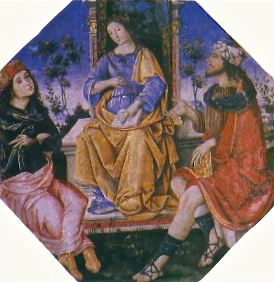 Isis the Wise, teaching Hermes and Moses, a painting by the Renaissance painter Pinturicchio from the Borgia family apartments
Isis the Wise, teaching Hermes and Moses, a painting by the Renaissance painter Pinturicchio from the Borgia family apartments
December 11, 2022
Who is Isis?
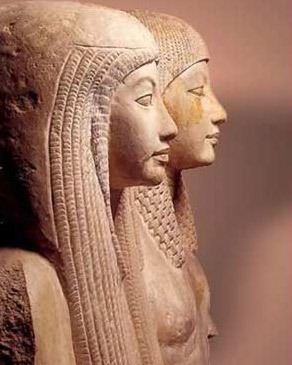 Can we relate?
Can we relate?Not just what we read about Her myths. Not just what we learn about Her history.
Who is Isis when we experience Her?
A gentle caress? An earthquake? A tingle up the spine that makes your hair stand on end? An anchor in the stormy sea of life?
Yes, She is all of those.
Yet many of us might start to describe Who She is by naming a relationship. She’s like a mother, a sister, a lover, a teacher. Since that’s the way we relate to the people in our lives, it makes sense that we would relate to Divine personalities in the same way. The models for relationship with which we have to work are the ones we’ve used all our lives, the human ones. And this approach works quite well, too.
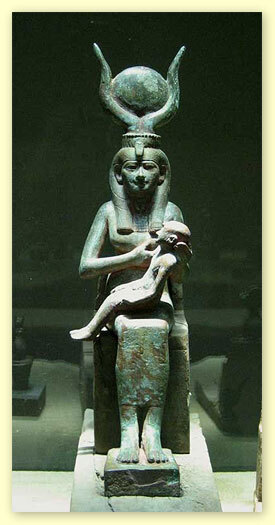 Isis, Mother of Horus, Divine Mother of us all
Isis, Mother of Horus, Divine Mother of us allI have been comforted by the motherly wings of Isis. I have argued with Her like a sister. I have been crazy for Her like a lover. I have bowed to Her will as to a queen. (In fact, a very interesting and worthwhile devotional exercise is to interact with Her in relationships like these—a different type of relationship each day for a week.)
But we must also remember that although Isis can relate to us in ways similar to human beings, Isis isn’t human. She’s a Goddess. She is Goddess. And that adds a whole new dimension to how we experience Her—and to Who we might think She is. Perhaps we can think of this as part of the priest/ess/ex-ly relationship, or the philosophical (remember it means “loving wisdom) relationship, or the mystical relationship.
 Isis the Magician with serpent wand
Isis the Magician with serpent wandAnswering the question of Who Isis is means trying to figure out what we think the Divine is and Who we think the Deities are (or Deity is, if that’s your preference).
Those are very big questions.
For myself, I have found the Qabalistic concept of the Four Worlds helpful in trying to sort all this out. Egyptian theology (to the extent that we can deduce it), along with Hermetic Qabalah and a dose of some sort of Neoplatonism, form the center of my own current understanding of the unmanifest and Divine realms. (Yes, I know it’s eclectic and I’m okay with that. And yes, I know it will change over, and I’m okay with that, too.)
In simplest terms, the Four Worlds concept envisions four levels of existence, which proceed from a unity at the highest level and become increasingly multiple with each successive stage. Yet all the levels remain intimately connected. This is reminds me of Jeremy Naydler’s (Temple of the Cosmos) expression of ancient Egyptian thought. The heavens, the earth, and the underworld exist together at all times, interpenetrating each other at all times.
 Diversity of life in the manifest world
Diversity of life in the manifest worldHere in the manifest universe, the Fourth World, we have diversity. Diverse plants, animals, people—and Deities.
The next level up (or in, or out, if you prefer) is also very diverse, but it’s the first of the unmanifest realms. For lack of a better term, we might call it the astral. In Qabalah, this level is the Treasure House of Images and contains, among many other things, spiritual images—thoughtforms, Godforms, Goddessforms—from the pantheons of the world. In our regular interactions with the Divine, this is most likely the level on/in which we’re interacting. When I talk to Isis and She answers me in words and images, this is probably where we’re connecting. This is the realm of visions and psychic perceptions, in part created by us.
A great example of this comes from a TV show from the early 2000s called Dead Like Me. (Bear with me, here.) It’s about a group of grim reapers whose job is to take human souls out of their bodies just before they die—and to send the soul to the next life. In the first season, we always got to see the souls as they walked into the afterlife—and each vision reflected the person’s individual belief about what “heaven” is like. The Buddhist was greeted by a meditating Buddha, the Christian by Christ, a child by a wonderful amusement park. That’s kinda my picture of what happens, too—at least during that first transition after death. Thus all religious traditions are true; if you’re picturing a purgatory, you’re probably going to find one. If you’re picturing a journey through the underworld with Re, you’re probably going to get it.
 What is your death dream?
What is your death dream?(On a side note, this is why I recommend having and practicing a death dream; by visualizing your transition in advance, you build up your own specific images in the Treasure House so they’ll be there for you when your time comes. As you might guess, mine is Egyptian flavored, with Wings and Her.)
The next level, the Second World, is known as the World of Creation. Here we find the Deities in a more concentrated expression. I sometimes envision Them as wellsprings or currents of Divine energy. Here is the creative numinosity that lies behind and empowers the many names and faces of the Divine found in the world’s many spiritual traditions. As a Great Goddess, the energy of Isis flows into our world through many of these channels, but we are always free to choose to connect with Her via whatever current particularly resonates with us. In Hebrew, this realm is usually called Briah, but an alternative name is Korsia, from a word meaning “seat,” and usually understood as the Throne, the same as the meaning of Isis’ name in Egyptian. Which I find quite interesting.
 One consciousness
One consciousnessThe next level is Unity, the undifferentiated Divine. Here, we can think of Isis is The Only One—as indeed the Egyptians called Her. Of course, if you were approaching from a different stream of the Divine current, Yahweh or Odin or Allah or Amun or Inanna would be The Only One. The Egyptians understood this; there were a number of Deities they called The Only One, though this designation seems to have been a particular title of the Great Goddesses and Gods. This harkens back to our discussions here and here.
For me, this underlying unity of the Divine is why I can know that Isis is the One Goddess and Mother of All Things one day, then the next, understand Dionysos as The One. Both are true. We only start messing things up when we begin insisting that our preferred stream of Divine current is the One True Way and, what’s more, there’s only one proper method for interacting with It.
Qabalah goes beyond this level of Unity, through the Veils of Negative Existence (a poetic description if ever there was one). This idea very much reminds me of the Egyptian Nun, the “watery” abyss of preexistence that Was Not.
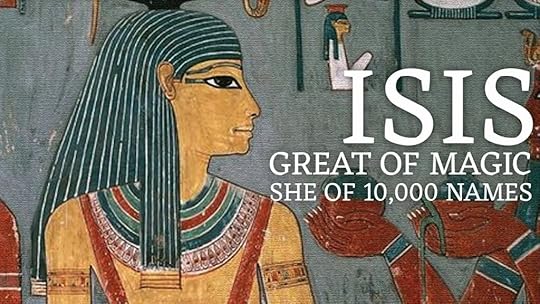
So. Who is Isis? Isis is the Only One, THE Goddess. At the same time, Isis is also to be found in the beautiful and perplexing diversity of our world. She is One and She is Many and She is One among Many. Isis was and is alive in all the homes people have created for Her throughout the millennia—from the marshes of the Egyptian delta to the island of Philae, from ancient Memphis, Rome, Athens, and Londinium to modern Oregon, Germany, and Japan. Differences in the cult or perceived character of the Goddess in all these times and places arise from the diversity of the people and cultures that honored Her, yet all were and are in contact with the Divinity that Isis is, was, and ever shall be.
December 7, 2022
The Occult Unveiled…with me!
A few days ago, I had the pleasure of chatting with Ashley Ryan, aka Pythian Priestess to those of you who TikTok, for her excellent podcast The Occult Unveiled.
We talked about all things Isis and the how, whys, and wherefores of Isis priest/ess/ex-hood. It was a fairly wide-ranging conversation and I think we could have gone on for much longer. Ashley is herself a priestess of Isis, so of course, we had a lot in common.
If you’d like to listen in, you can find The Occult Unveiled wherever you get your podcasts or here.
 The Occult Unveiled podcast, with Ashley Ryan
The Occult Unveiled podcast, with Ashley RyanYou can see all The Occult Unveiled podcasts here.
And I’d love to have more conversation on this topic. Are you a devotee of Isis? What does it mean to you? Are you a priest/ess/ex? What does that mean to you? Let’s talk.
December 5, 2022
Weaving Magic with Isis, Nephthys & Tayet
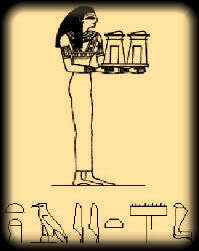 Tayet with Her name in hieroglyphs below
Tayet with Her name in hieroglyphs belowIn Isis Magic, the “Ritual of Becoming the Beloved of Isis,” the initiatory rite for the Prophet/ess of Isis, involves three priestesses who takes the roles of Isis, Nephthys, and Tayet. Why is Tayet—a much less well known Goddess than either Isis or Nephthys—part of this important ritual?
In the rite, the initiand symbolically dies, is mummy wrapped, and is eventually reborn as the Beloved of Isis. Since Tayet is the Linen Goddess Who weaves the mummy wrappings, it is fitting that Her priestess be part of the rebirthing.
Yet the connection between Isis, Nephthys, and Tayet is more interesting than that.
 A modern illustration of an ancient Egyptian fresco of weavers at work
A modern illustration of an ancient Egyptian fresco of weavers at work
As is true of many of the Egyptian Deities, scholars are unsure as to the origins of the worship of Tayet. Judging by Her name alone, it may be that She was first worshiped in the lower Egyptian “weaving town” of Tayet. As far as I can tell, the town itself has not been found, just written references to it. Later, Tayet was an alternate name for Buto in the lower Egyptian delta…so it may be that the weaving town of the inscriptions was actually Buto from the beginning. Indeed, the first evidence of Egyptian weaving comes to us from lower Egypt during the Neolithic period.
An inscription from the much later temple of Hathor in Denderah says that Tayet was born in Denderah. Yet the Denderah shrine in which this inscription occurs bears the name of a shrine in Buto, and so it makes a good deal of sense to continue to strongly connect Tayet with Buto.
If Buto was Her original hometown, it is worth noting that Buto is not very far at all from Isis’ great temple at Isiopolis. (Please see my notes on Isiopolis here to see why I think the site may be a very old Isis site, even though the visible ruins are late.)
 This lovely illustration isn’t Tayet, but Neith, another Goddess of Weaving (and a lot more)
This lovely illustration isn’t Tayet, but Neith, another Goddess of Weaving (and a lot more)Since both Isis and Nephthys are weavers (They are specifically known as the Abuti, or Two Weavers), it makes sense that Tayet would become connected to Them. But here’s another very interesting connection: Tayet also has the form of a kite hawk, the sacred raptor of both Isis and Nephthys. According to the Pyramid Texts:
While the Great One sleeps upon his mother Nut, your mother Tayet clothes you, she lifts you up to the sky in this her name of ‘Kite’; he whom she has found is her Horus. (Pyramid Texts, Utterance 417)
Also interesting is the fact that Isis’ temple at Isiopolis makes much of Her connection with the kite, or djeret. So we have three Goddesses—all three connected with the kite, with weaving, with rebirth of the dead—and also with purification. Old Kingdom texts refer to a woman called the Kite who was the pharaoh’s chief female funerary attendant and who was supposed to “remove poisons” from the deceased. The linen itself is considered to be divinely pure: An ancient Egyptian medical spell meant to prevent bleeding, warns against “treading on what is pure, the land of Tayet.” In other words, the spell is intended to keep blood from seeping from the wound and staining the pure bandage woven by the hand of the Goddess Herself.
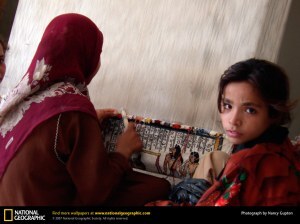 Modern Egyptian woman and girl weaving one of the ancient patterns
Modern Egyptian woman and girl weaving one of the ancient patternsThe purificatory role of Kite was sometimes associated with Tayet; at other times, two women ritualists were designated as Kites and connected with Isis and Nephthys. In addition to Their role in purification, the Divine Kites were responsible for ferrying the pharaoh—and Osiris—to the otherworld.
The first pictorial representation of Tayet that we have left to us is from the Osiris chapel at Karnak. She is shown as a human woman holding two pieces of cloth and facing Isis and Osiris. At Denderah, She is shown a number of times, including some instances in which She is specifically connected with Isis. By the New Kingdom, we find the hyphenated Goddess Isis-Tayet. At Kom Ombo, Tayet’s image is portrayed in a vestibule of the Birth House. So, like both Isis and Nephthys, Tayet is connected with coming into and going out of life.
And here’s an interesting speculative connection between Isis and Tayet: in Coffin Text spell 282 for “Becoming Tayet,” Tayet is said to “make a seat” for the deceased so that the person need not “lie down in the shambles” of the otherworld. Making a seat for the deceased establishes a place for her or him and affords protection. As Isis’ name means “Throne,” She Herself is a Divine Seat and well known as a protective Goddess. (See more about the .)
 The mummy wrappings of Tayet, from a tomb
The mummy wrappings of Tayet, from a tombAt Denderah, Tayet is said to have been born with green skin. This may be a reference to the green and growing flax from which linen will eventually be made, for She is also said to be pale in complexion, like the white linen once the process is complete. On the other hand, Tayet may be green-faced for the same reason that both Isis and Osiris are sometimes portrayed as green-faced. They are green because They are Deities associated with rebirth; They are the Living, Green Ones of the Other world; They promote each person’s rebirth like the new green shoots of plants in the fields. Tayet is said to be the wife of Nepri, the young God associated with growing grain and Whom Osiris, in His rebirth, is said to Become.
And let us not forget that more than cloth was woven in ancient Egypt. Magic was also a woven thing and weaving was one of the key methods for working magic. An ancient formula to cure a poisoned cat says that Isis has “spun something” and Nephthys has “woven something” against the poison. Numerous funerary texts say that magic is knit or woven around the deceased. The dead person is “knit together in the egg” prior to rebirth, or her head is “knit on” by the Deities.
 Woven magic—the heka-infused mummy wrapping
Woven magic—the heka-infused mummy wrappingMany modern magic workers would agree that the joining together of the threads of energy that are one mechanism of magic can be aptly described by actions such as weaving and knitting. The spell is woven, thread by thread, until the whole is created out of what was almost nothing. This idea can also be related to Egyptian knot magic in which the surrounding or encircling of the two ends of the knot creates the magic circle or egg within which the threads of magic are then woven to create a blanket of creative, healing, and renewing energy.
(If you’d like to know more about Tayet from ancient sources, Edward Butler of the Henadology blog has collected many of the texts referring to Tayet for us here. Thank you, Edward!)
I find Tayet strangely compelling. For a Goddess with so little specific myth, She seems to me to cast a very large shadow—or better still, a large aura. It is almost like She is the Third Sister, joining Isis and Nephthys in all Their majesty. She intrigues me, though I can never quite get a full sense of Her. If you’ve had any contact with Tayet, I hope you’ll share it. In the meantime, may She and Her Two (adopted?) Sisters bless you.
November 27, 2022
Isis, Horus & the Holy Day of December 25th, Updated
 The Holy Mother & Her Holy Child
The Holy Mother & Her Holy ChildEvery year, at about this time, one post on this blog starts to get a lot more “traffic,” that is, visitors viewing it, than any other. (In fact, it’s already started.)
It’s the one about Horus being born on December 25th. Likely, people are searching for information about how Christianity absorbed Pagan winter solstice traditions (from the non-Christian side) or how it most certainly did not (from the Christian side). The statement about Horus’ birth on that date is often used to dismiss the Christian tradition of the birth of the Christ on December 25th (and by inference, Christian tradition in general) as “mere Pagan superstition.” Which is rude to both Pagans and Christians.
Early Christianity most certainly was influenced by the people and cultures around it. But the thing I specifically wanted to look into was the birth of Holy Baby Horus from the Holy Virgin Isis on December 25th.
 Gotta love the expression of both Deities’ faces.
Gotta love the expression of both Deities’ faces.What bothered me about it was that I thought that the December 25th date was stretching the truth to make a point; the point being that the “real meaning of Christmas” was, in fact, the celebration of a Pagan Deity Who was born on the winter solstice. Why should we have to distort the truth to make that point?
As you might expect from a sun-focused culture—the winter solstice was quite important in Egyptian culture and religion. There are many inscriptions and texts to support this, as well as a number of temples and monuments oriented toward the winter solstice sunrise. Temples with that orientation were often dedicated to Re-Hor-Akhty, Re-Horus of the Horizon.
In the 17th year of the reign of Pharaoh Amenemhet I (approx. 1991-1962 BCE), the king chose to take a new title as the sun approached winter solstice. The title was Nem-mestu, Repeater of Births. This designation was also given to the dead and may refer to daily/yearly solar rebirth or even to reincarnation.
 Amenemhet I, Repeater of Births
Amenemhet I, Repeater of BirthsBut still, that’s the winter solstice, usually December 21 or 22, not December 25.
The Greek priest Plutarch, writing in the late 1st and early 2nd century CE, is our source for the most complete version of the Isis and Osiris myth that we have. In his essay, he mentions several Egyptian winter solstice traditions, including the birth of Harpokrates (from Hor-pa-khered, Horus the Child) on the winter solstice. (I quote it here at length because I like the snarky lead-in):
Thus we shall attack the many boring people who find pleasure in associating the activities of these gods with the seasonal changes of the atmosphere or with the growths, sowing, and plowing of crops, and who say that Osiris is being buried when the corn is sown and hidden in the earth, and that he lives again and reappears when it begins to sprout. For this reason it is said that Isis, when she was aware of her being pregnant, put on a protective amulet on the sixth day of Phaophi, and at the winter solstice gave birth to Harpocrates, imperfect and prematurely born, amid plants that burgeoned and sprouted before their season . . . and they are said to celebrate the days of her confinement after the spring equinox.
Plutarch, On Isis and Osiris, 65B-c
Since Horus is a solar God, His birth at the winter solstice—even to the extent that He is “imperfect and prematurely born” at that time—makes symbolic sense. (Calendar translation is always tricky, but in this later period, the 6th of Phaophi would be sometime in October or November by our calendar. So if Isis was going to give birth at the solstice, She would have had to have been pretty inattentive to have only worn a protective amulet that late in Her pregnancy. Seems more likely that She put on the protective amulet in the more dangerous weeks just prior to giving birth.) This tradition of Horus’ winter solstice birth was still going strong in the 4th and 5th centuries CE. Another writer, Macrobius, famous for his book about the Saturnalia festival, notes that:
…at the winter solstice, the sun would seem to be a little child like that which the Egyptians bring forth from a shrine on the appointed day, since the day is then at its shortest and the god is accordingly shown as a tiny infant.
Macrobius, Saturnalia, 1.18:10

The Egyptians weren’t the only ones to note and welcome the winter solstice with its soon-to-be-lengthening days. Just as there are today, there were other winter holy days around the time of the winter solstice. You’re probably familiar with the Roman Saturnalia (Greek Kronia) which took place from December 17th through the 23rd (at its most developed stage). It was a carnivalesque festival with plenty of partying and gift-giving on the last day, just a day or two from the astronomical solstice.
The 4th century CE Christian polemicist, Epiphanius, notes two very interesting Pagan festivals that took place “on the very night of Epiphany,” which is Epiphanius’ preferred date for the birth of the Christos (January 6). He grouches that “many places deceitfully celebrate a very great festival on the very night of the Epiphany, to deceive the idolaters who believe them into hoping in the imposture and not seeking the truth.” (Epiphanius, Panarion, 22,8) Of the celebration in Alexandria, he writes:
First, at Alexandria, in the Koreum, as they call it; it is a very large temple, the shrine of Kore. They stay up all night singing hymns to the idol with a flute accompaniment. And when they have concluded their nightlong vigil, torchbearers descend into an underground shrine after cockcrow and bring up a wooden image which is seated naked on a litter. It has a sign of the cross inlaid with gold on its forehead, two other such signs, one on each hand and two other signs, one actually on each of its two knees—altogether five signs with a gold impress. And they carry the image itself seven times around the innermost shrine with flutes, tambourines and hymns, hold a feast, and take it back down to its place underground. And when you ask them what this mystery means, they reply that today, at this hour Kore—that is, the Virgin—gave birth to Aion.
Epiphanius, Panarion, 22,9
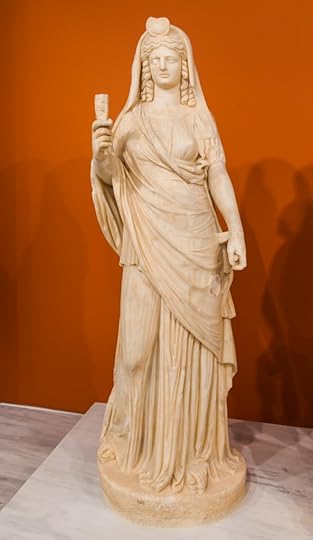 Isis-Kore/Persephone, from Heraklion, Crete
Isis-Kore/Persephone, from Heraklion, CreteSome scholars believe that the Alexandrian Kore or Virgin was Isis (some ancient Egyptian Hymns call Isis “virgin;” in the Hermetic text, Kore Kosmou, Isis is likely the “Cosmic Virgin” of the title) and that the “crosses” on Her limbs may have been ankhs. Could be, but doesn’t have to be; Alexandria was, after all, a polytheistic city. Epiphanius goes on to mention other identical and, in his mind, deceitful festivals in Petra and in Elusa celebrating the birth of the “only son of the Lord” of a Virgin Goddess. In Petra, the Holy Child is Dusares, an Arabian God identified with Dionysos, Who was, in turn, identified with Helios, the sun. (Epiphanius, Panarion, 22,11)
Those of you who have been following along with this blog may recall that the famous Roman Calendar of Philocalus (354 CE)* lists a festival called The Isia from October 28 through November 1.**
Much earlier, in the 1st century BCE, the Greek mathematician and astronomer Germinos noted that the Greeks believe that the Isia—which was derived from the ancient Egyptian Khoiak festival—occurs at the winter solstice. (The Khoiak festival celebrated the death of Osiris and His finding, lamentation, and resurrection by Isis.) Germinos says that that was true 120 years ago, but that, in his time, it had shifted a month earlier. The modern Kemetic Orthodox religion celebrates the Khoiak Festival in late November; so just about now.
 Isis and the pharaoh raise the Djed pillar, the symbol of the resurrection of Osiris, as part of the Khoiak festival
Isis and the pharaoh raise the Djed pillar, the symbol of the resurrection of Osiris, as part of the Khoiak festivalHowever, here at the 45th parallel, we are happily privy to a calendar Mystery. The ancient Khoiak Festival took place in the fourth month of Inundation, which began on the Egyptian New Year. As you likely know, the New Year was heralded by the heliacal rising of Sirius, the Star of Isis. The festival took place over a period of many days, culminating at the end of the fourth month with the resurrection of Osiris.
Here in Portland, the Star of Isis rose this year on August 23. Four 30-day Egyptian months from that date is December 21, the winter solstice. So if you were here in Portland with me, we could celebrate the Isia on the days leading up to and ending with the winter solstice.
Yet, as fabulous as that is, it’s still not December 25th, is it?
Well, as it turns out, the answer to this little puzzle is not all that mysterious after all.
You see, the Roman calendar went through a certain amount of upheaval and—bottom line—December 25th was considered the “traditional” date of the winter solstice, even if that was off from astronomical solstice. (If you want to calendar geek on that, check this out or this.) From a number of ancient sources, including Epiphanius, we have that “the eighth before the kalends of January” was considered to be the winter solstice. (Epiphanius, Panarion, 22,3) Because of the inclusive way the Romans counted, this “eighth before the kalends” was December 25th. (In the Roman calendar, the kalends is the first day of the month.)
What’s more, the early Christians who chose that date, chose it precisely because it was the winter solstice and was connected to the return of the light. In a work attributed, perhaps falsely, to the 4th century Christian church father John Chrysostom, the writer connects the birth of Jesus with the birth of Sol Invictus, the Unconquerable Sun, which was celebrated on Rome’s traditional winter solstice, December 25th:
But Our Lord, too, is born in the month of December . . . the eighth before the kalends of January [25 December] . . ., But they call it the “Birthday of the Unconquered.” Who indeed is so unconquered as Our Lord? Or, if they say that it is the birthday of the sun, He is the Sun of Justice.
Chrysostom, De Solstitia et Aequinoctia Conceptionis et Nativitatis Nostri Iesu Christi et Iohannis Baptistae; “On the conceptions and births of our Jesus Christ and John the Baptist on the solstices and equinoxes.”
Another interesting thing about the choice of December 25th is that—even just those few days after the astronomical solstice—you can begin to see that the light is indeed returning. Some scholars have suggested that the December 25th date for the solstice reflects this perceivable change, so that even though the exact moment of astronomical solstice is prior to the 25th, it becomes noticeable about the 25th.
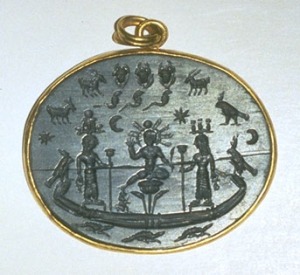 On this protective amulet, Isis & Nephthys guard the shining solar child, Horus.
On this protective amulet, Isis & Nephthys guard the shining solar child, Horus.So there we have it. There actually IS reason to connect the winter solstice birth date of Isis’ Holy Child, Horus, with the traditional December 25th birth date of Mary’s Holy Child, Jesus.
Should we claim that early Christians “stole” the birthdate of Horus (or any of the other solar Gods Who always were and always will be born on the winter solstice)? Nah, let’s not. In fact, it makes perfect sense to celebrate the birth of Jesus Christ, the bringer of the light of Christianity to its believers, at that time of year when the light of the sun begins its return to the world. It is an excellent symbol and early Christians would have been silly to ignore it.
 Artist Alex Grey’s mesmerizing Cosmic Christ
Artist Alex Grey’s mesmerizing Cosmic ChristNor does the fact that Christianity has so many Pagan antecedents (that we don’t have to stretch the truth to connect) mean Christianity was built on a lie. Of course early Christianity was influenced by the many religions around it. And we must remember that much early Christian development was in Alexandrian Egypt. For early Christians, as for ancient Egyptians—and indeed for modern people as well—the return of the light at the winter solstice is at once an uplifting environmental fact and a hopeful spiritual symbol.
And so, as we count down the waning days of the year, I wish you all Many Happy Returns of the Light as we celebrate the upcoming holy day of December 25th.
*The reason Philocalus’ calendar is so famous, is that it contains the oldest reference to a regular celebration of the birth of the Christos. The calendar notes: “Eighth day before the kalends of January, Birth of Christ in Bethlehem of Judea.” Earlier, one of the Church fathers, Cyprian (200-258CE), commented how very, very providential it was the when the sun was born, so was Christ.
**If we go by Philocalus, that late October-early November date for the Isia, with its emphasis on death, lamentation, and renewal, makes a perfect option for our own Samhaim/Halloween celebrations.
November 20, 2022
Raw Nephthys
I had nothing specific in mind for today’s post. So I did a bit of meditation with the Beautiful Sister, Senet Noferet, and I’ll share with you what we did.
 Blue Lotus Garden by Luiz Celestino, copyright Luiz Celestino. See the work, contact the artist here.
Blue Lotus Garden by Luiz Celestino, copyright Luiz Celestino. See the work, contact the artist here.
 The sacred scarab
The sacred scarabI used the Nephthys contact ritual I have been working with (I cannot believe it’s been almost a year since then), but in my smaller shrine rather than the larger temple space, so I was seated almost the entire time. I purified and consecrated, established the Horizons, invoked Her…
And now, I am within Nephthys’ temple garden.
The strong scent of greenness and the life of animals comes to my nose. It smells good, alive, alive. I look around, orienting myself. I see the serpents, the birds, and now a scarab dung beetle, a creature I had not seen before in Her temple. I follow the windings of the artificial channel of the Nile that flows through the temple and fills the sacred lake. Her garden is becoming familiar to me.
 Eternity is in Her Wings
Eternity is in Her WingsBut She has done something unexpected. I don’t have to go to Her throne-room to find Her. Instead, She is standing in the shallow sacred lake, Her feet in the water and the bottom of Her robe wet to the knees. She is smiling. When She knows that I have seen Her, in an instant, She grows to an immense size. Her dark wings unfurl, enclosing the entirety of the garden temple. “Eternity is in My wings,” She says, “Everlastingness is in My heart.”
I feel my mind expanding beyond the confines of my head; it is dizzying. Behind my closed eyelids, I see—literally see, as dark patterns on the inside of my eyelids—wings. “Unending depth is here,” She says, “do you feel it?” I do feel it.
 The sun born from the petals of the blue lotus
The sun born from the petals of the blue lotusBlue lotuses begin to bloom around Her. “Lotus petals or wings,” She says, “it is all the same thing.” (What She means, I think, is that the petals in a flower and the feathers in a wing must open, expand, to do their work (like my head is expanding now). Petals gather sunshine and attract the pollinating insects. Wings gather the wind and move the bird as it flies and hunts.)
 Impossibly long stem
Impossibly long stem
 The blue Egyptian water lily
The blue Egyptian water lilyAnd now, I realize that I am a blue water lily, planted in the sacred lake of Nephthys. And the lake is not at all shallow, as I had thought. My head is fat and full. My consciousness is in my head, and beyond, and below, and…way beyond. I realize that I am sensing my roots and leaves. I am floating, swaying, waiting. As She has said, unending depth is here.
My slim stem is impossibly long as I pull up nutrients from below. My feet are in cool, wet, and somewhat sticky mud that is kicked up by the tiny fish feeding where I, too, am feeding. Nephthys says, “The dead are here.” (She means that life feeds on death, as it ever, ever was. The dead send up ka energy to the living that they may live. We return it to them when we die.)
“Now, rise up,” She says. (And I remember that She has said this to me before, as a uraeus.) I do. My fat head blossoms and a golden sun burns upon my forehead. Magic heat floods my body. (I mean this literally. When magic happens, my body frequently responds with a flush of heat. I know this happens to others. To you?)
Above me, I see the Goddess, wings outspread. Her heart is a sun. Her eyes are on fire. Above Her extend the nourishing rays of the Sun God. She is mediating His power to me like the World Soul (sorry, different mythology, but it’s in my head, so there we are). Re burns above, the lotus sun in my forehead burns below. “Stop striving,” Nephthys instructs. And I notice my body has tensed to, what?…stop the sense of expansion? I relax my body. Our three suns connect. My mind, my heart, and my lotus body expand again. And further. “This is Everlastingness,” She says.
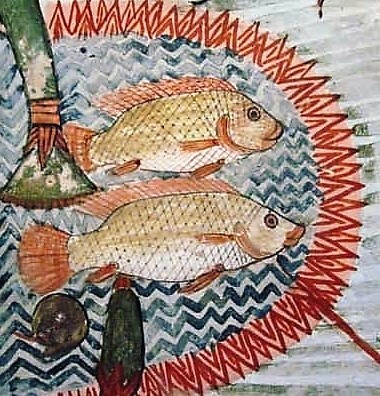 The Egyptian bolti fish or talapia
The Egyptian bolti fish or talapiaNext, I am aware of the fish nibbling at my roots. It reminds me of a lake in Tennessee where our family would vacation. My brothers and I would float in the water while tiny fish would nibble at our toes.
In a flash, the Goddess has transferred my consciousness into a fish. No, transfer is too gentle; more like “thrown.” Oof. My eyes seem to work a bit independently of each other. I am swimming through reeds. I am very fast or very still. I move. Then I float. I breathe. It is weird; like my lungs are not in my body. What am I supposed to learn from being a fish I wonder? “Simplicity,” She says aloud in my head.
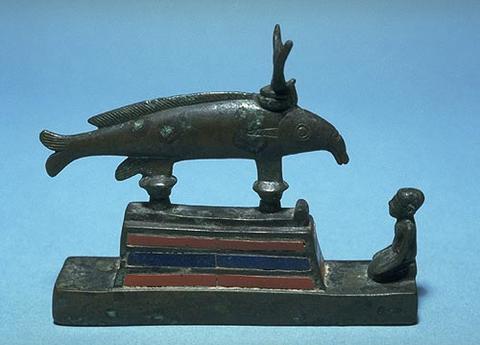 Oxyrhynchus fish, sacred to Hathor and the one that ate the phallus of Osiris, with devotee
Oxyrhynchus fish, sacred to Hathor and the one that ate the phallus of Osiris, with devotee “I am not sure I like being a fish,” I say. She laughs and asks why. “I don’t know. My life is complex right now. And simplicity seems both unattainable and uncomfortable.”
“Learn how,” She says. “Are You simple?” I ask. “I can be,” She answers. “That is the lesson: control it. Simplicity is a kind of purity.” (I am thinking about this and it comes to me that there is a kind of ‘fish meditation’ possible, focusing simply on the awareness of self in existence. Similar to mindfulness meditation? It is a type of meditation I rarely do. Mostly, my meditations are like this one, intentionally receiving visions.) “Fish (She means the ongoing lifecycle of fish) is Eternity,” She says. “Fish meditation is Everlastingness.”
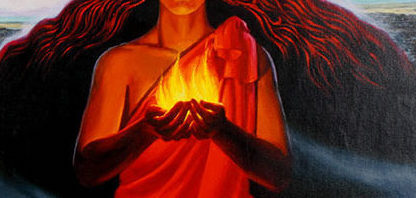 She gives me some of Her ka
She gives me some of Her kaThe magic heat fades a bit and I am standing before Her in the water. And, for the first time, I can see Her face. Wide, dark, almond eyes with fire in them. Wide mouth with a gentle smile. She places Her palm upon my heart and gives me some of Her ka. I give Her some of mine in return. “This will help you form your akh,” She says. Then She flows back into the water. I am left with wet feet and a robe wet up to my knees.
As I am wont to do, I look things up after visions like this. There were some mild synchronicities. One was the scarab beetle, the dung beetle. I hadn’t seen one in Nephthys’ temple garden before. As it turns out, the most important pollinators of the sacred blue water lily (and other water lilies) are beetles.
 The giant night-blooming water lily, in its female phase
The giant night-blooming water lily, in its female phaseI haven’t found out the exact kind, so that probably means there are several types. But I did learn that the scarab beetle is the main pollinator for a specific type of night-blooming water lily: the Amazonian giant water lily. These are ones with leaves big enough for a human to sit in. Not Egyptian, but this is one amazing water lily. It blooms at night as a female with a white blossom and strong scent. The scent attracts the beetle, which comes in with pollen of a male flower on its body. Once pollinated, the flower turns pink and male, and the once-more pollen-carrying scarab is on to the next flower. And we have yet another example of gender change in Nature.
The other synchronicity was small, but sweet. After the lessons on simplicity in this vision, I looked at the music that I had chosen in advance. The title of one song was “Simplicity.”
As I said, everything here is a bit raw. I haven’t figured out all the things I’m supposed to learn yet. But for today, for now, that is how it went.



